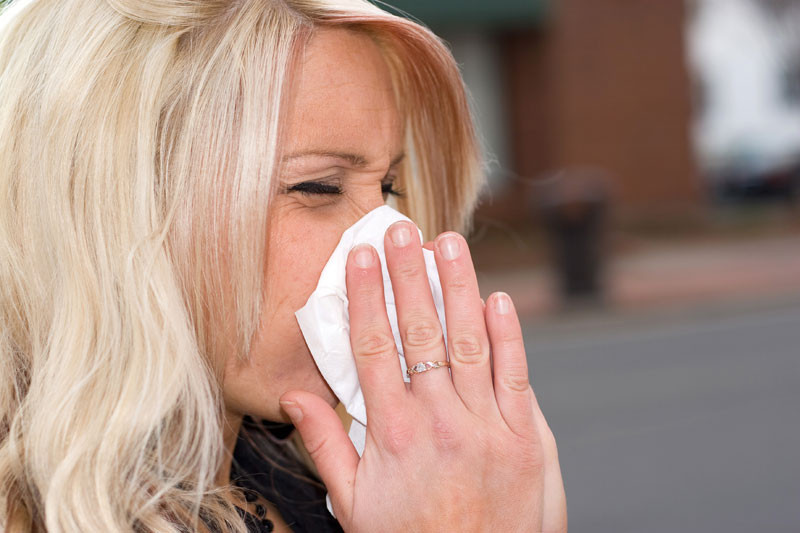If it's not bad enough that we get spring allergies, now we have entered the annual hot zone when fall allergies rear their ugly heads, often disguised as weed pollens. It's all in the pollen, mostly, per what health experts say, and it is the type of pollens, mainly, that differentiates spring allergies from fall allergies. The symptoms are pretty much the same from one season to the other: sneezing, runny nose, itchy and/or watery eyes, headache, sinus pain and pressure; asthma symptoms, too, per metro.us. One quick side note from the author of this blog, who didn't know there was such a thing as fall allergies until moving to Tennessee – sinus drainage and accompanying coughing seems to be more of an autumn problem. One man's experience, at least. There can be more culprits in the fall, says Dr. Milo F. Vassallo, a New York-based allergist and immunologist, quoted at metro.us, while explaining the difference between spring allergies and the fall variety. Overall, in spring, outdoor allergens are mainly tree pollens and, in the fall, it's weed pollens, like ragweed. That's also complicated by molds, which [grow in] early fall's warm, wet weather. Indoor allergens can be guilty as heck, too. Vassallo continues: In late fall, when the weather gets colder, people close their windows and seal up their home. They pull out old comforters and quilts. Then, the dust mite problem escalates, and even sensitivities to their pets worsen. As I often say, people are potentially sleeping with the enemy. Beware Piles of Fallen Leaves In those parts of the country where leaves flutter down from trees and tend to flock on the ground, there's lots of raking and piles of leaves to deal with. That can be a problem, in the form of mold, which can often be found in piles of dead leaves. If you are planning to rake leaves into piles to be bagged (or burned, although many cities and towns now forbid that), consider wearing gloves as well as a NIOSH-rated 95 filter mask for protection from the possible effects of mold. Dust mites and pet dander also are problematic sources of allergies, for which diagnosis can be tricky. Allergy symptoms in large part mimic symptoms of a cold, so a visit to your physician might be worthwhile so you can figure out what it is that is bugging you and, therefore, how best to protect or heal yourself. How to Combat Fall Allergies Speaking of protecting yourself at this beautiful time of year (think slightly cooler temps and colorful foliage in many places), here are some helpful hints, with a helping hand from health.usnews.com, to assist you in preparing for the arrival of fall allergies or at least alleviating symptoms if you've already been hit:
- Consider using allergy medication. If you take allergy medication when allergy season hits, such as over-the-counter (OTC) remedies like Loratadine, Benadryl, and Zyrtec, consider getting back on your regimen right now to prepare your body's defenses. Then once you have worked your way through fall allergy season and the pollen counts start dropping to normal ranges, keep taking your medication for another couple weeks just to be safe. Visit your physician or, better yet, an allergist so you can be properly tested for allergies and have him or her devise a health plan for you.
- Get rid of mold. Again, keep those work gloves and filter mask handy. Mold can be found in many places, not just leaf piles. Garages, basements/cellars, and bathrooms (sinks especially) are breeding grounds for mold. The key thing is to minimize moisture. If you find standing water or even just droplets anywhere in the house, dry it up.
- Steer clear of pollen. Do the best you can in keeping pollen out of your house, and be wary of spending too much time outside, as nice as the autumn weather can be. Take your shoes off when entering the house and bathe (preferably in a shower) immediately after you've been working or exercising outdoors. Also, wash your clothes frequently (and don't hang-dry them outdoors). Consider running a dehumidifier in your home as well – aim to keep your air indoors between 35 and 50 percent humidity.
- Remain indoors. Well, maybe becoming a total recluse is out of the question, but at least when you are indoors, keep doors and windows closed during peak periods of pollen. Also, change out vents throughout the house, and cover your mattress and pillows in dust-proof covers.
- Bathe furry pets. Do this frequently. Got cats? Got dogs. Got both? Keep 'em clean.

